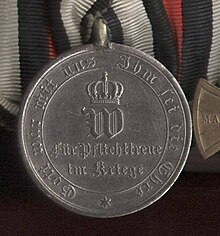War memorial for the campaigns 1870–71 (German Empire)
The war memorial for the campaigns of 1870/71 was donated by Kaiser Wilhelm I on May 20, 1871 for combatants and non-combatants and awarded to all members of the German armies who took part in a battle or siege in the war of 1870/71 or for military purposes had crossed the border with France , as well as to all members of the navy who had participated in a battle in this war, as well as to the crew members of the SMS Augusta , who served on the ship from December 11, 1870 to March 2, 1871.
It is not entirely clear whether this award, which was first donated after the founding of the German Empire, was one of the same or that of the Kingdom of Prussia. While the Prussian kings never carried the imperial title when they were awarded Prussian medals, this commemorative coin was expressly donated by Wilhelm I as emperor under the countersignature of the imperial chancellor and also paid for from the imperial budget (RGBl. 1871 No. 22, p. 103; publication No. . 642); The same happened with later medals and medals of merit donated - mostly also for military actions. The ribbon colors black, white and red are the colors of the newly created German Reich, and the lump-sum award to all members of the non-Prussian army contingents makes it clear that it was an honor by the German Reich. The fact that the initial on the obverse of this commemorative coin is crowned with the Prussian royal crown may be due to the fact that the design of the imperial crown - which never actually existed, but was only used as a symbol - was not yet determined at the time.
Appearance
For combatants, the medal is made from the bronze of captured gun barrels and shows the initial W (Wilhelm) on the front in the center of a royal crown surmounted by a royal crown . Below the inscription To the victorious army and all around God was with us, to him be the glory . The reverse shows a cross with rays between the four arms and the years 1870 and 1871 surrounded by a laurel wreath on its center shield . On the edge of the coin is embossed: AUS CONQUERED ARCHITECTURE.
The medal for non-combatants is made of steel , with only minor differences. In the center, the inscription for loyalty to duty in war and an oak wreath on the reverse .
Carrying method
The medal was worn on the left chest on a black, white-rimmed ribbon with a red stripe in the middle. For non-combatants, the ribbon is the same as for the combatant medal, only for military officials and people who did not belong to the armed forces, the non-combatant medal was also worn on a special non-combatant ribbon, the color of which was white with black borders and a red stripe in the middle would have.
Combat clips
On the occasion of the 25th return of victory on August 18, 1895, the following battle clasps were donated to the medal
- Battle of Weissenburg
- Battle of Spichern
- Battle of Wörth
- Battle of Colombey - Nouilly
- Battle of Vionville - Mars la Tour
- Battle of Gravelotte - St. Private
- Battle of Beaumont
- Battle of Noisseville
- Battle of Sedan
- Battle of Amiens
- Battle of Beaune la Rolande
- Battle of Villiers
- Battle of Loigny-Poupry
- Battle of Orleans
- Battle of Beaugency-Cravant
- Battle of the Hallue
- Battle of Bapaume
- Battle of Le Mans
- Battle of the Lisaine
- Battle of St. Quentin
- Battle of Mont Valerien
- Siege of Strasbourg
- Siege of Paris
- Siege of Belfort
- Siege of Metz
The clasps are made of gold-plated brass or gold-plated bronze and were only allowed to be attached to the band of the combatant medal. To participate in several battles, the clasps were attached to each other. Since the battle clips had to be procured retrospectively by those entitled at their own expense, they are much rarer than the medal given by the state.
Others
All the originals of the combatant medal awarded bear the marginal inscription AUS CONQUERED ARMY , as they are made from approx. 280 hundredweight French bronze cannon barrels that have been captured. The steel non-combatant medals have no inscription on the edge. There are a large number of contemporary combatant medals that have no marginal inscription and that have the band ring attached to a narrower, non-grooved loop. They are duplicates that you could buy in stores at the time and that those entitled to buy were at their own expense. These second or replacement pieces also come in a gold-plated - and at the time correspondingly more expensive - luxury version.
literature
- Army Ordinance Sheet 1871 No. 12, p. 123.
- Baden Military Ordinance Sheet 1871 No. 13, p. 113.
- Statute concerning the donation of a war memorial for the campaigns of 1870/71 . In: Reichsgesetzblatt 1871 No. 23, p. 111f, publication No. 645.
- Hessenthal, Schreiber: The portable decorations of the German Empire. Berlin, 1940.
- Jörg Nimmergut : German medals and decorations until 1945. Volume 2. Limburg - Reuss. Munich 1997, p. 1083ff
- Maik Without Time: For "heroic bravery" and "glorious acts of glory": the war memorial from 1870/71. In: Information and reports from the Braunschweigisches Landesmuseum. 1/2008, pp. 18-21.




